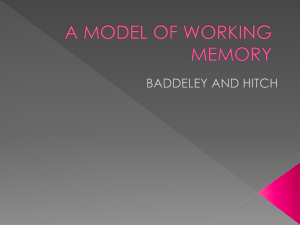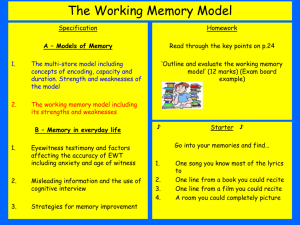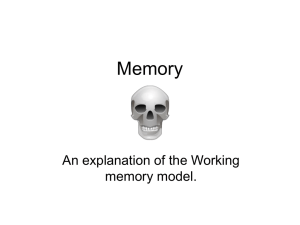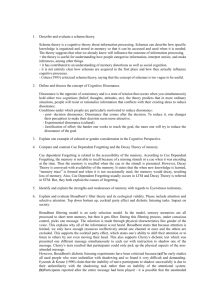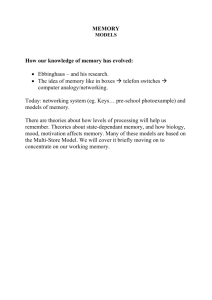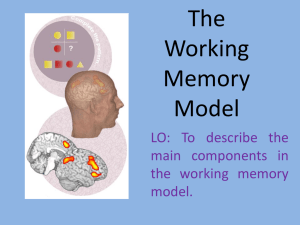Chapter 1
advertisement
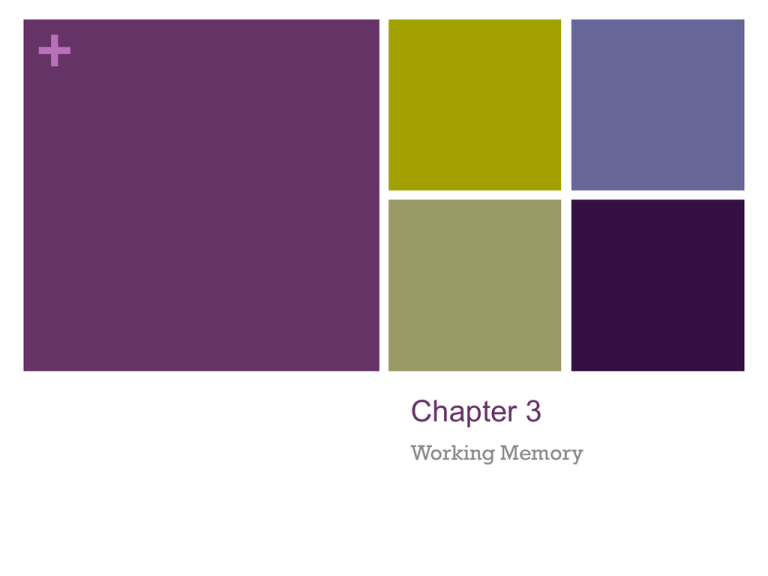
+ Chapter 3 Working Memory + Atkinson and Shiffrin’s (1971) Modal Model Environmental Input Sensory Registers Detect sensory input from the various modalities Visual, auditory, haptic, etc. Memories are held for only a few hundred milliseconds Short-Term Store (STS) Lasts a few seconds and is made up of: Temporary working memory Control processes: Rehearsal Coding Decisions Retrieval strategies Long-Term Store Permanent memory store + Problems with the Modal Model Levels of Processing Evidence Atkinson and Shiffrin’s Modal Model of Memory: Assumes that holding items in the short-term store is sufficient for long-term learning But … Craik and Lockhart’s (1972) data show that: Learning depends on the way the material is processed, rather than time in short-term storage (levels of processing theory) Neuropsychological Evidence The Modal Model predicts: That STM is crucial in transferring information into and out of LTM. Any STM deficit should greatly impair LTM learning, in addition to reasoning & comprehension problems. But … a number of patients: Had severe STM deficits without apparent working memory or LTM deficits. + Baddeley and Hitch (1974) Attempted to simulate an STM deficit to see how STM influenced reasoning, comprehension, and learning tasks. The Technique: Require participants to repeat a sequence of digits out loud while concurrently performing a variety of cognitive tasks. The digits should fill up STM and interfere with doing the tasks. The Test: Increasing the STM load by adding more digits should cause more interference in reasoning. However … The Results: Participants were able to reason without difficulty, even when repeating sequences of up to eight digits. Reaction times did slightly increase with digit load but the number of errors did not increase. + Sample Reasoning Task True A follows B BA B precedes A AB B is followed by A BA X A is preceded by B AB X A is not preceded by B AB X B does not follow A AB False X X X + STM Digit Load & Reasoning Speed and accuracy of grammatical reasoning as a function of concurrent digit load. From Baddeley (1986). Copyright © Oxford University Press. Reproduced with permission. Response time increased but the number of errors did not. + Baddeley and Hitch (1974): Implications Since the error rate of the reasoning task remained constant across digit loads (around 5%), working memory does not appear to depend entirely on the same underlying memory system as digit span. There does, however, appear to be some interaction between these systems, as the processing time did increase with increasing number of digits to be recalled. To address these difficulties, Baddeley and Hitch (1974) proposed a model of working memory (WM) -- a system that supports complex cognitive activities like reasoning instead of just storage (like STM). + Baddeley and Hitch’s (1974) Multi-Component Model Central executive: an attentionally-limited system that selects and manipulates material in two slave systems: Phonological loop: holds sequences of acoustic or speech-based items Visuo-spatial sketchpad: holds visually and/or spatially encoded items and arrays + The Phonological Loop Aids Language Learning The Phonological Loop: Corresponds to the previous idea of verbal STM (see Chap 2, pg 27-33) Is the best studied component of WM Includes a temporary store and a verbal rehearsal process. What is it good for, besides letting people rehearse (repeat) items mentally and thereby increase their digit span by two to three items when repeating back numbers? Neuropsychological Evidence suggests the loop is important to language learning because patients with impairments cannot learn a new language: Patient PV had acquired a pure phonological loop deficit as an adult, resulting in a digit span of two items. She had only relatively minor language comprehension problems with very long sentences but a profound inability to learn a new language. + PV was Unable to Learn a New Language Rate of learning pairs of items by patient PV and controls. Her capacity to learn pairs of meaningful words was unimpaired (panel a), but she was not able to learn foreign language vocabulary (panel b). From Baddeley, Papagano, and Vallar (1988). Copyright © Elsevier. Reproduced with permission. PV’s performance with new vocabulary words. + The Phonological Loop What Happens with Normal Adults? Testing the language acquisition rationale with normal participants Papagno, Valentine, and Baddeley (1991) found that: Repeating an irrelevant sound disrupted foreign language learning without affecting learning native language word pairings – this showed the phonological loop was involved. Papagno and Vallar (1992) Varied either phonological similarity or the length of paired words – both known to influence the phonological loop. When the response words were foreign, both factors impaired performance more than when the response words were from the native language. + The Phonological Loop What Happens with Language-Impaired Children? Gathercole and Baddeley (1990) tested 8-year-old children with a specific language impairment. The Task: The nonword repetition test: Pseudo words of increasing length are heard and must be repeated (e.g. BALLOP, WOOGALAMIC, VERSATRATIONAL). Ability to do this task well correlates with vocabulary development and is used to help diagnose dyslexia. Studies reveal that phonological memory is crucial for early vocabulary acquisition (Gathercole & Baddeley, 1989) Results: Language-disordered children were impaired on the nonword repetition task, performing like 4-6 year old normal children. + Children with Specific Language Impairments Percent correct repetition of nonwords by children with a specific language impairment (A), children of the same age (B), and children matched for language level but half their age (C). Adapted from Gathercole and Baddeley (1990). + Normal Children and Non-Word Repetition (Table 3.1) Measures Correlation coefficient Simple regression (% variance) Stepwise regression (% variance) Chronological age 0.218 5a 5a Nonverbal intelligence 0.388 15b 13b Nonword repetition 0.525 27b 15b Sound mimicry 0.295 9b 0 Total 0.578 33b -- ap < .05; bp < .01 + The Phonological Loop and Action Control Vocally or subvocally reminding oneself of the relevant task often improves performance. Articulatory suppression limits this ability and disrupts performance (example – alternation of addition & subtraction). Vygotsky (1962) and Luria (1959) emphasized the use of verbal self-instruction to control behavior. Studied as a means to help brain-damaged patients rehabilitate and to understand childhood development. Largely underappreciated and under-investigated currently. + The Visuo-Spatial Sketchpad Imagine what you had for Breakfast. How Vivid is Your Visual Imagery? People’s subjective report of the vividness of their visual imagery is largely unrelated to their performance on visual tasks. People who report more vivid imagery do not necessarily have better memories They tend to use vividness as a sign of accuracy, sometimes mistakenly. Subjective reports may reflect the way in which we choose to categorize and describe our subjective experiences, rather than their content/capacity. + The Visuo-Spatial Sketchpad Image Manipulation Imagine folding the shapes below to create a solid, with the shaded area as the base. Will the arrows meet head on? Shepard and Feng (1972) found that the time it takes to answer the question depends on the number of folds required Men are typically better than women on spatial manipulation tasks, but this appears largely due to differences in strategies, which when taught to women eliminate the gender bias. Sample Spatial Manipulation Task First, form an image of the capital letter J. Then imagine capital D. Now rotate the D through 90 degrees to the left and place it on top of the J. What does it look like? J D D + J An umbrella Articulatory suppression was used to disrupt the phonological loop and spatial tapping was used to disrupt the visuo-spatial sketchpad. + The Visuo-Spatial Sketchpad Concurrent Tasks Pearson et al. (1999) used one of two concurrent tasks while participants were attempting to spatially manipulate components to form a novel object (umbrella) and/or remember the individual components (e.g., J, D). Articulatory suppression disrupted the capacity to remember the component shapes, suggesting that the phonological loop held the names of the components. Tapping a series of spatial locations disrupted the capacity to create novel objects but spared the capacity to remember the component shapes, suggesting that the sketchpad is important for the former but not the latter. Concurrent spatial activity is especially disruptive to individuals who rely heavily on visuo-spatial imagery to perform specialized tasks (example: visualizing an abacus). + The Visuo-Spatial Sketchpad Concurrent Tasks Just as spatial processing can interfere with imagery, imagery can interfere with spatial processing. For example, imagining the sports events being reported on a car radio can disrupt one’s ability to safely navigate the road ahead. Visual imagery can aid memory, but it can also be disrupted by the presentation of irrelevant pictures or colors which participants are instructed to ignore. + Disruption of Competing Tasks Left above: Examples of the material developed by Brooks and used to study the visuo-spatial sketchpad. Participants must repeat the sentences from memory but can use the matrix to help them. Data from Brooks (1967). Right: The influence on recall of the Brooks sentences on a concurrent visuo-spatial tracking task. Data from Baddeley et al. (1973). + Vividness of Subjective Experience Baddeley and Andrade (2000) Hypothesis: Vividness of visual imagery reflects the operation of the sketchpad; auditory imagery reflects the phonological loop Task: Participants asked to form and judge the vividness of visual or auditory images before being tested under one of the following: Baseline conditions Articulatory suppression conditions—predicted to reduce vividness of auditory imagery Concurrent spatial tapping conditions—predicted to reduce vividness of visuo-spatial imagery + Working Memory and Visual Imagery Baddeley and Andrade (2000) Results: When images were novel, auditory imagery was less vivid under articulatory suppression and visual imagery was less vivid under spatial tapping, just as predicted. When images were drawn from long-term memory, however, there was far less of an effect. Interpretation: The loop and sketchpad only limit detail when the image depends on STM – fed by current experience. When the image is based on LTM, it is much more reliant on a fourth component of working memory, the episodic buffer. + Proposed Structure of the Visuo-Spatial Sketchpad Logie (1995) suggests that the structure of the visuo-spatial sketchpad is similar to that of the phonological loop, in that it consists of: The visual cache: A passive store. The inner scribe: An active spatial rehearsal process Logie suggests that the sketchpad offers a mental workspace for complex tasks and (controversially) is always fed by LTM + The Central Executive The central executive is thought to be an attentional controller, with two main modes of operation (Norman & Shallice, 1986): A semi-automatic conflict-resolution system, based on existing habits and requiring little attention. Conflicts are routinely resolved without much conscious awareness. The supervisory attentional system (SAS), based on an attentionally limited executive. Crucial to the central executive. Able to intervene when automatic conflict resolution is not possible or when a new situation arises. + The Supervisory Attentional System (SAS) When the SAS Fails Occasionally, the SAS doesn’t initiate when it should have. Patients with frontal lobe damage appear to have problems with attentional control, suggesting that SAS relies on this brain region. They often perseverate (repeatedly perform the same action or mistake with difficulty stopping or changing behavior). They often fail to focus attention, resulting in utilization behaviors (uninhibitedly making use of whatever cues are afforded by the environment to guide behavior). They often fail to monitor behavior (fail to make sure they are behaving appropriately for the situation) or recognize when their statements don’t make sense (confabulation). + The Central Executive Attentional Focus A major function of the central executive is to direct attention to the task at hand, such as planning the next chess move or remembering positions. Robins et al. (1996) tested expert & novice chess players – similar factors affected performance: Performance was unaffected by articulatory suppression, suggesting that the phonological loop wasn’t involved. A concurrent visuo-spatial tapping task impaired performance somewhat, indicating the involvement of the sketchpad. Greatest disruption came from an attentionally demanding random generation task (producing a random stream of numbers), suggesting involvement of the central executive. + The Central Executive Dividing Attention Another major function of the Central Executive is to divide attention between two or more tasks. Concurrent verbal reasoning tasks (e.g. talking on a cell phone in the car) can impair judgment while driving, even though driving skill remains intact. Alzheimer’s patients have particular difficulties dividing attention between simultaneous tasks, even when they are all very simple. A three-way conversation is difficult for them. Some aspects of switching between more than one task can be relatively automatic, while others demand attention. + Problems with the ThreeComponent Model of WM The three-component model of WM cannot explain why memory span can sometimes exceed the capacity of the subsystems (as much as 15 words in a sentence). for words in a sentence Aspects of LTM (e.g. grammar) help to chunk the items; yet, we lack an explanation of how LTM and WM interact for digit span (6 or 7 items) If the phonological loop can store only about three items, where are the rest stored? If they are stored in visual STM, how does this interact with phonological STM? The model also cannot explain why images based on LTM do not depend on the sketchpad or phonological subsystems. + The Episodic Buffer A Solution to the Problems with the WM Model? Episodic Buffer -- A newly proposed fourth component of the WM system. Originally assumed to be controlled by the central executive. A storage system with a capacity of around 4 chunks of information in a multidimensional code. Multiple dimensions permit links between the subsystems, as well as with LTM & perception. Information is retrieved through conscious awareness – consciousness pulls info together. Allows for the binding of previously unrelated concepts -- disrupting the executive does not impair binding, so it may be automatic/passive. + The Current Model An elaboration of the original three-part model with a few major changes: Added two links from phonological and visuospatial subsystems to LTM Arrow A: language acquisition Arrow B: visual and spatial mapping Added the episodic buffer Accessed through either subsystem and/or the central executive Possibly linked to emotions B A A + Individual Differences in WM WM Span A competing approach to WM inspired by Daneman and Carpenter’s (1980) study of language comprehension. Task: Read a series of sentences and try to recall the last word of each: It was a cold winter with many violent storms. Results: WM Span: People remember the last words of around two to five sentences. WM Span for this task predicts: prose comprehension, ability to follow complex instructions and take notes, performance in computer programming courses, IQ reasoning measures, fluid intelligence. + Individual Differences in WM Complex Span Gathercole et al. developed a diagnostic battery that: Tests the various WM subsystems and complex span task (visual/verbal processing tasks involving simultaneously storing and manipulating information, thereby exercising the central executive). Can detect and predict learning problems in school-age children. Indicates the separate components of WM differentially relate to academic performance: Phonological STM and the complex span task predict delayed reading and arithmetic abilities in 7 to 8-year-old children. Complex span continues to predict math and science scores through age 14. Her work led to a program designed to help teachers identify WMimpaired students and modify their teaching accordingly. Related to ADHD – attention deficit hyperactivity disorder. + Alternative Theories of WM Based on Measuring Individual Differences Why do complex span measures predict problems with learning and differences in performance? To study this, researchers break performance down into tasks tapping various components and look at relationships among them. Most analyses result in conclusions that broadly agree with Baddeley and Hitch’s model of WM and include: An attentionally-based control system, like the central executive. Subsystems dealing with the simple storage of verbal and visuo-spatial material. + Theories of WM Cowan’s Embedded Processes Theory WM depends on activation that takes place within LTM and is controlled by attentional processes. Activation is temporary and decays, unless maintained through active verbal rehearsal or continued attention. Activated memory is multidimensional, with some resemblance to the episodic buffer. WM capacity is limited to around four chunks (NOT six to seven, as suggested by Miller, 1956) Adapted from Cowan (1988). + Theories of WM Engle’s Inhibitory Control Theory Turner and Engle (1989) suggest an operation span similar to the complex span. To measure it, they use the following task. Task: Remember a set of words, each of which is followed by arithmetic operations (e.g. APPLE, 7 + 2 − 1 = ?; HOUSE, 5 − 1 + 6 = ?; etc.) Results: Correlates highly with the original complex span (sentences). Individuals with a low operation span are more susceptible to proactive interference than are those with high operation spans. An inability to resist interference also predicts one’s susceptibility to the cocktail party effect (being distracted by hearing one’s own name in a stream of noise). Conclusion: The ability to inhibit irrelevant material is tied to complex span/WM. + Theories of WM Time-Based Resource Sharing Model Assumes that complex span reflects the capacity to prevent the decay of the memory trace through rehearsal. Resource-Sharing Hypothesis (Barrouillet et al., 2004): Rehearsal need not be subvocal, but can simply be intermittently focusing attention on the fading trace. Evidence: Simple articulatory suppression is not sufficient to diminish performance on the Peterson task. Suggests that even complex tasks allow brief gaps in which rehearsal may occur, unless their pacing is rigidly controlled. Task-Switching Hypothesis (Towse & Hitch, 1995): Assumes a trace decay with participants switching between maintaining the trace and performing the secondary task. + Long-Term WM (Ericsson & Kintsch, 1995) This theory of long-term working memory proposes that: LTM is utilized to assist in temporary storage. The ability of mnemonic strategies to vastly increase the apparent capacity of WM is related to this integration with LTM. Example: use of running times to encode 80+ digits or visualizing an abacus to aid calculation. However, this theory only addresses this particular use of LTM, not the entire WM system. + The Neuroscience of WM Single-Cell Recording Single-Cell Recording An electrode is placed in individual brain cells (typically of an awake monkey) so that the neuronal activity can be recorded under various experimental circumstances This technique was pioneered by Nobel laureates Hubel and Weisel (1979) Funahashi, Bruce, and Goldman-Rakic (1989): Discovered cells in the monkey’s frontal lobe that were active during the retention intervals on successful trials of a memory task (but not on unsuccessful ones) Suggested that these areas of the frontal lobe were important for WM Future work has identified similarly responsive cells outside of the frontal lobe, indicating a more general WM network + Neuroimaging WM Paulesu, Frith, and Frackowiak (1993) Used PET to find: A) An area between the left parietal and temporal lobes appeared related to phonological storage B) A more frontal region called Broca’s area, known to be involved in speech production, was linked to subvocal rehearsal Redrawn from Paulesu et al. (1993). + Similar Findings for Visuo-Spatial PET Imaging Illustration depicting PET images of the four areas activated in the visuo-spatial working memory study. Based on Smith et al. (1996). + Neuroimaging WM Smith and Jonides (1997) Also used PET to directly compare visual and verbal WM Verbal task: Decide whether a letter was one of four previously presented Replicated the two activations for verbal STM in the left hemisphere Visual task: Decide whether a circle appeared on the location of one of three previously presented dots Found right-hemispheric areas associated with the visuo-spatial sketchpad Smith et al. (1996). Copyright © Oxford University Press. Reproduced with permission. Further studies supported the dorsal (“where”) stream vs. ventral (“what”) stream distinction Spatial memory activates more dorsal regions of the brain Object/pattern memory activates more ventral areas Based on Smith et al. (1996). + Neuroimaging WM The N-Back Task 1-back 1 7 N-back task: Press a button whenever an item was seen N-items before 2-back Increasing the lag increases the difficulty and executive load 7 The frontal lobe is engaged during this task and its involvement increases with executive load 9 9 3 6 2 6 3 3-back 7 4 3 2 4 Button Press

